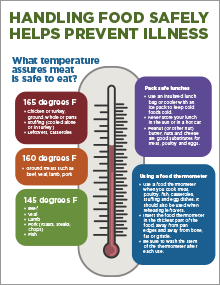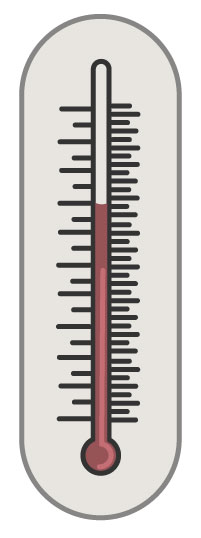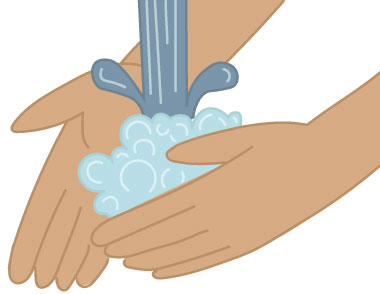Revised
Editor’s note
You can read this publication on this page or download the PDF.
See the companion publication N1003, Food Safety Poster.

This handout provides tips for the safe handling of food to prevent illness. It includes steps for proper food handling from cleaning to separating to cooking to chilling foods.
The printed version is a two-page 8.5-by-11 inch handout.
See handout content below.
Handling Food Safely Helps Prevent Illness
What temperature ensures meat is safe to eat?

165 degrees
- Chicken or turkey, ground, whole or parts
- Stuffing (cooked alone or in turkey)
- Leftovers, casseroles
160 degrees
- Ground meats such as beef, veal, lamb, pork
145 degrees
- Beef
- Veal
- Lamb
- Pork (roasts, steaks, chops)
- Fish
Pack safe lunches
- Use an insulated lunch bag or cooler with an ice pack to keep cold foods cold.
- Never store your lunch in the sun or in a hot car.
- Peanut (or other nut) butter, nuts and cheese are good substitutes for meat, poultry and eggs.
Using a food thermometer
- Use a food thermometer when you cook meat, poultry, fish, casseroles, stuffing and egg dishes. It should also be used when reheating leftovers.
- Insert the food thermometer in the thickest part of the food, away from pan edges and away from bone, fat or gristle.
- Be sure to wash the stem of the thermometer after each use.
Steps to food safety

Clean
- Be sure to wash dishes, utensils and countertops with hot, soapy water after food preparation.
- Wash cutting boards in the dishwasher or in hot, soapy water after each use.
Separate
- If you use reusable grocery bags, be sure to wash them often. Put raw meat into a plastic bag first.
- Never put cooked food on a plate that just held any type of raw meat or seafood.
Cook
- Cook ground beef to at least 160 degrees F. The color of the meat is not an indicator it has reached the proper temperature.
- Cook eggs until the yolks and whites are firm. Don't use recipes in which eggs remain raw.
Chill
- The refrigerator should be set at 40 degrees F or below. These temperatures help assure the safety as well as the quality of the food.
- Refrigerate leftovers such as meat, poultry, seafood, dairy foods and eggs within two hours of the meal. Sooner is better!
Funded in part by USDA SNAP.
For more information, call MU Extension’s Show Me Nutrition line at 1-888-515-0016.
Need help stretching your food dollars? Contact your local resource center or go online to mydss.mo.gov/food-assistance/food-stamp-program.